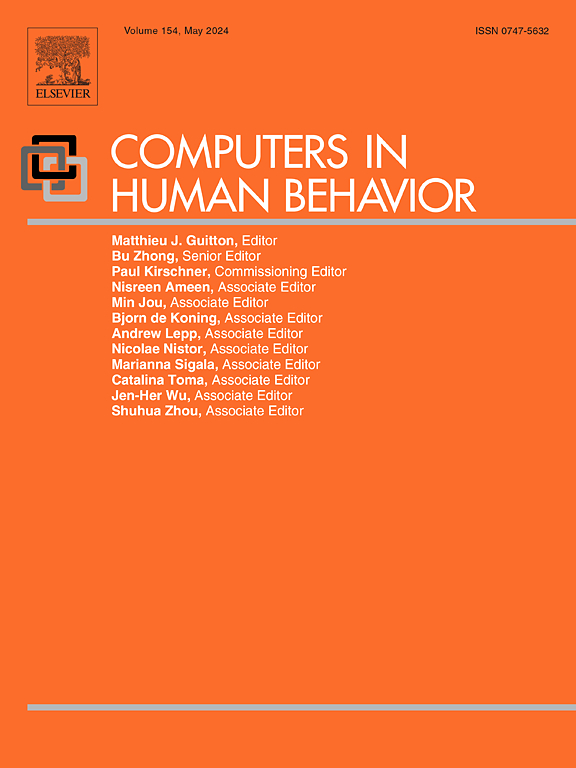不同类型的自我调节支架对超媒体科学学习的影响
IF 8.9
1区 心理学
Q1 PSYCHOLOGY, EXPERIMENTAL
引用次数: 0
摘要
在考虑学生个体差异的同时,在超媒体中有效使用支架应该支持学生的自我调节学习。元认知和认知支架,而不是动机支架,已经得到了广泛的研究。没有明确的证据表明,只使用一种支架比组合不同类型的支架更有效。本研究的目的是确定在超媒体中使用不同类型的支架及其组合是否能预测超越学生个体差异的学习成绩。在我们的准实验研究的第一阶段,443名九年级学生学习了超媒体中的视觉感知。我们测量了他们的个人特征(平均绩点(GPA)、智力(IQ)、学习时间和使用的学习策略的数量)和学习成就,并将他们分为六个可比组。在第二阶段,各组使用嵌入在超媒体中的不同支架学习嗅觉知觉:6个认知支架,6个元认知支架,6个动机支架,全部18个支架,6个混合支架的选定子集,以及没有支架。我们进行了前测和后测来评估学生的学习情况,并收集了学生记笔记、自我报告的学习策略使用情况以及对主题的兴趣等数据。对288名学生的数据进行层次回归分析发现,GPA较高、对某一主题有特定先验知识和兴趣的学生,以及使用更多自我调节策略的学生学得更多。支架对学习结果的预测没有显著的帮助。讨论了研究超媒体中学习支架的影响对研究设计的影响。本文章由计算机程序翻译,如有差异,请以英文原文为准。
The impact of different types of self-regulation scaffolds on learning science with hypermedia
Effective use of scaffolds in hypermedia should support students' self-regulated learning while considering their individual differences. Metacognitive and cognitive scaffolds, but not motivational scaffolds, have been extensively researched. There is no clear evidence that using only one type of scaffold is more effective than combining different types. The aim of this study was to determine if the use of different types of scaffolds and their combination in hypermedia predicts learning achievement over and above individual student differences. In the first phase of our quasi-experimental study, 443 ninth graders learned about visual perception in hypermedia. We measured their individual characteristics (grade point average [GPA], intelligence [IQ], learning time, and the number of learning strategies used) and their learning achievement and divided them into six comparable groups. In the second phase, the groups learned about olfactory perception using different scaffolds embedded in hypermedia: 6 cognitive, 6 metacognitive, 6 motivational, all 18 scaffolds together, a selected subset of 6 mixed scaffolds, and no scaffolds. We administered a pre-test and a post-test to assess what students learned, and collected data on students’ note-taking, self-reported use of learning strategies, and interest in the topic. Hierarchical regression analysis of data from 288 students revealed that students with a higher GPA, specific prior knowledge and interest in the topic, and those who used more self-regulation strategies learned more. Scaffolds did not significantly contribute to the prediction of learning outcomes. Implications for the research design of studies investigating the effects of learning scaffolds in hypermedia are discussed.
求助全文
通过发布文献求助,成功后即可免费获取论文全文。
去求助
来源期刊

Computers in Human Behavior
Multiple-
CiteScore
19.10
自引率
4.00%
发文量
381
审稿时长
40 days
期刊介绍:
Computers in Human Behavior is a scholarly journal that explores the psychological aspects of computer use. It covers original theoretical works, research reports, literature reviews, and software and book reviews. The journal examines both the use of computers in psychology, psychiatry, and related fields, and the psychological impact of computer use on individuals, groups, and society. Articles discuss topics such as professional practice, training, research, human development, learning, cognition, personality, and social interactions. It focuses on human interactions with computers, considering the computer as a medium through which human behaviors are shaped and expressed. Professionals interested in the psychological aspects of computer use will find this journal valuable, even with limited knowledge of computers.
 求助内容:
求助内容: 应助结果提醒方式:
应助结果提醒方式:


